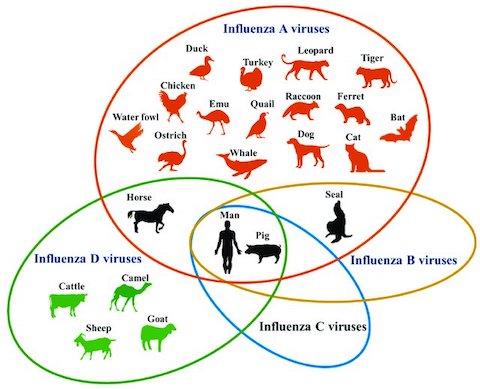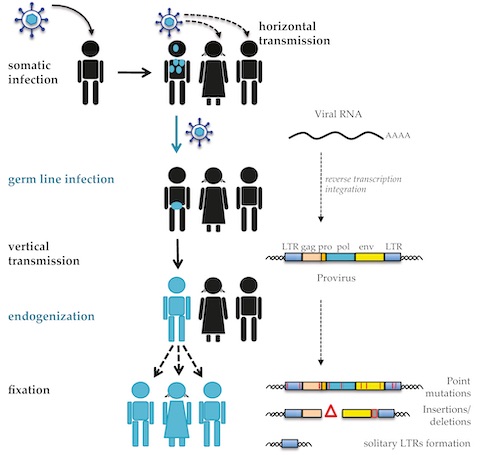
When scientists mapped the human genome, they found that just 2% of it controlled our own functioning. Fully 8% was the DNA of fossil viruses.
Paleovirologists who study fossil viruses have found that all viruses share a common single-cell ancestor from more than 3 billion years ago.
About 1.5 billion years ago, viruses changed their protein coating, allowing them to penetrate the cells of their hosts.
As multicellular life became increasingly complex, viruses got simpler, eventually giving up independent life. They threw out genes they didn’t use and discarded their means of reproduction until they were totally reliant on cell hosts.
When a virus enters a cell, part of its RNA is converted to DNA within the cell’s gene code.
If that cell is an egg or sperm, that DNA could be passed to the next host individual.
However, that can only happen if the virus does not kill the host.
So, if the virus is beneficial or benign—or if the host’s immune system is able to defeat it and become healthy enough to reproduce—then the viral DNA can be passed down through generations.
This process has occurred enough times over millions of years for viral DNA to make up that 8% of our gene code.
And fossil viral DNA has been very beneficial to us and all other organisms, as we’ll discuss in another EarthDate.
Background
- Researchers have found fossilized microbes like bacteria and fungi, but fossils of viruses have never been found in ancient rocks.
- Their fragile structures consist of just a few strands of genetic material and protein coatings that are easily broken down as rocks lithify, so direct fossil evidence isn’t preserved. Viral chemical and biosignatures, however, are still under assessment.
- But we can find viral fossils that preserve genetic code from millions of years ago hiding in our very own genomes and in the genomes of every other living thing—from other mammals to plants to fungi to bacteria and archaea.
- Paleovirology, the study of extinct fossil viruses, helps us to reconstruct the past history of various species and the viruses that shaped them, as well as helps us to shape effective responses to new viruses.

- Where did viruses come from?
- Researchers have used a detailed study of protein folding to show that viruses and bacteria descended from a common ancestor—a fully functioning cell that lived 3.4 billion years ago and was one of Earth’s earliest life forms.
- About 1.5 billion years ago, viruses changed the structure of their protein coat, enabling them to enter host cells.
- Eventually they diverged from cellular life and evolved into simpler symbiotic forms, throwing out genes they didn’t use until they ultimately discarded their own mechanisms for reproduction, becoming dependent on cellular hosts.
- Whereas cellular life evolved to be more complex, viruses evolved to be simpler.
- Viruses are masters of their own rapid evolution.
- Some evolve over decades or centuries, but others—like influenza—evolve so rapidly that different vaccine formulations are required each year to bolster our immune systems.
- Viruses also evolve zoonotically, jumping from one organism to another.

- Recent studies have shown that viruses can also cause their host organisms to evolve, and the evidence is found within the host’s very own genome.
- When researchers mapped the human genome in 2003, they found more than 3 billion haploid base pairs organized into the genes on our 23 chromosomes.
- They were surprised to find that less than 2% of the genome carries the coding for the creation of proteins, the building blocks of life that keep our cells functioning.
- The remaining 98% of our genome consists of a tangle of old genes that don’t function anymore along with strings of repetitive DNA and other elements with no obvious function.
- Within this junkyard of genetic material, researchers found that 8% of our DNA consists of forever-deactivated fossils of defeated viruses that infected our ancestors but lost the battle with our immune system. These are called endogenous retroviruses (ERVs).
- Retroviruses are thought to have originated in marine environments more than 460 million years ago, during the Ordovician Period. They only infect vertebrates.
- When a retrovirus infects a cell, it takes over most cell functions and directs the cell to create an enzyme that converts the virus’s RNA to DNA. Bits of that DNA are inserted into the host cell’s chromosome using another enzyme the retrovirus directs the cell to manufacture.
- If the infected cell is a sperm or egg cell, the retrovirus becomes “endogenous,” meaning its altered DNA can be passed down through generations.
- ERVs are not able to produce new viruses; they are segments of DNA left behind by the genetic engineering of a past virus.

- Like other life forms, humans have been engaged in a continual battle with viruses.
- Viruses invade, so our immune system fights back by changing the shape or composition of its proteins to defeat them. Meanwhile, the viruses struggle to evade our defensive response.
- Pandemics and epidemics punctuate human evolution—populations either adapt or they go extinct. Endogenous retroviruses record the evolution of our proteins, revealing details of these past evolutionary conflicts.

